

|
 |
| Heron Foods 9-11 High Street West |
Town Hall High Street West |
Various 1-3 Market Arcade |
| Market Hall High Street West |
Norfolk Square |
Various 4-6 Market Arcade |
| 1838 | 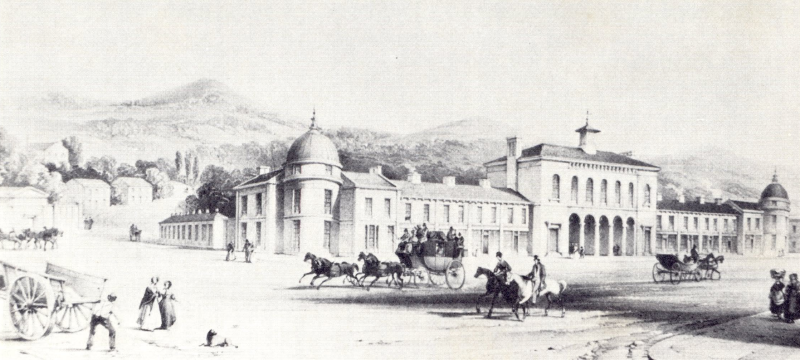 The 12th Duke of Norfolk, Bernard Edward Howard engaged the architects Messrs. John Grey Weightman and Matthew Ellison Hadfield of the Corn Exchange Buildings, Sheffield, to prepare plans for a Town Hall with four shops either side, flanked by tower shaped buildings complete with domes, the dome to the right was never built. The foundation stone of this impressively designed, Italian style Town Hall was laid on 28 June 1838 the Coronation Day of Queen Victoria. |
| 1844 | By 1844 a savings bank was held in the Town Hall on Mondays. The building also housed the Glossop County Court. |
| 1857 | Whites Directory of Derbyshire and Sheffield A handsome Town-hall and Market-house was erected in the Italian style, of which the first stone was laid 28th June, 1838, (the coronation of Queen Victoria,) and opened as above stated. A Lock-up prison was erected in connection with the above. It contains 4 cells which are warmed by hot water. Mr. William Hatton is the superintendent, with four assistant constables. Behind the Town Hall is a covered Market-house, with shops for butchers, greengrocers, and other trades. The tower which crowns the Town Hall is provided with an excellent clock, and the whole enclosed by a low wall and palisading. The entire cost has exceeded £8,500, executed under the superintendence of Messrs. Weightman and Hadfield, architects, Sheffield. |
| 1871 | Census The town hall also recorded as the Borough Police Office was occupied by William Beard 41, the Superintendant of Police, wife Alice Beard 40 and daughter Eliza Jane Beard 10. |
| 1881 | Census The Town Hall was occupied by Albert Barber 63, a Watch Maker. The Town Hall was also occupied by Abel Hall 31, a Police Constable for the Borough of Glossop, wife Martha Hall 38, daughter Martha Emily Hall 5, a Scholar, his mother-in-law Eliza Wilson 69, formerley a Housekeeper and his sister-in-law Eliza Wilson 27, a Cotton Weaver. |
| 1891 | Census Town Hall was occupied by Thomas Hall 48, a Police Constable, wife Grace Hall 49, daughter Charlotte Hall 18, a Cotton Weaver and son Robert Hall 16, an Office Boy. |
| 1897 | The original square clock turret was replaced in 1897 by a domed cupola. The Town Hall remained in the ownership of the Duke throughout the 19th century. |
| 1901 | Census Town Hall was occupied by Thomas Hall 58, a Police Constable, his wife Grace 59, daughter Charlotte Whitehead 28, a Cotton Weaver, son Robert Hall 26, a Woodpulp Boiler in the Paper Works and grandson Leonard Whitehead 6. |
| 1904 | 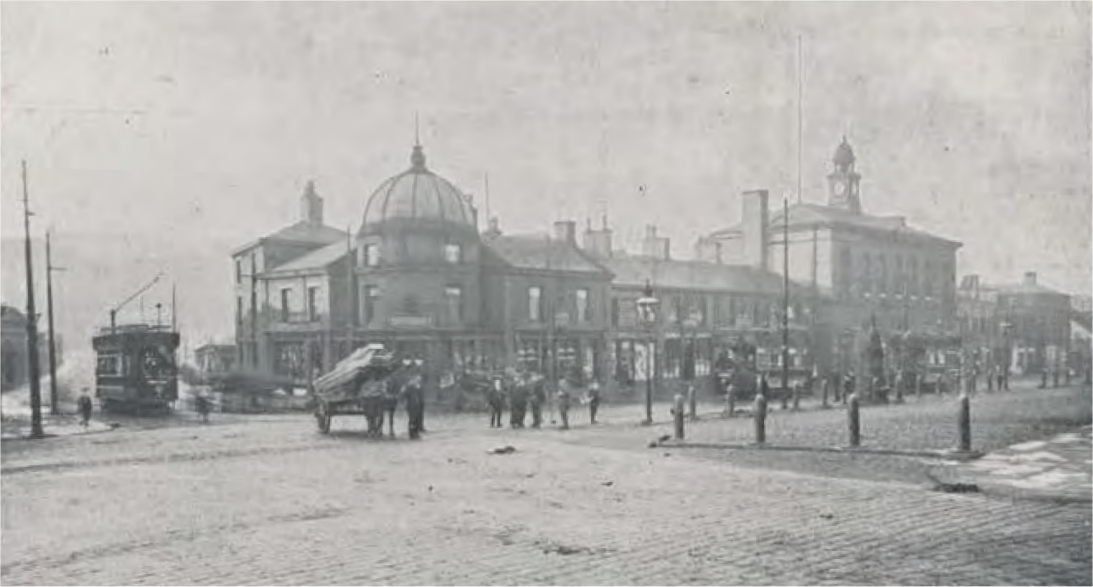 An photo from ’Glossop - A Sketch From The Earliest Period’ printed and published by Messrs. Jenkinson and Hamnett in 1904. |
| 1906 | 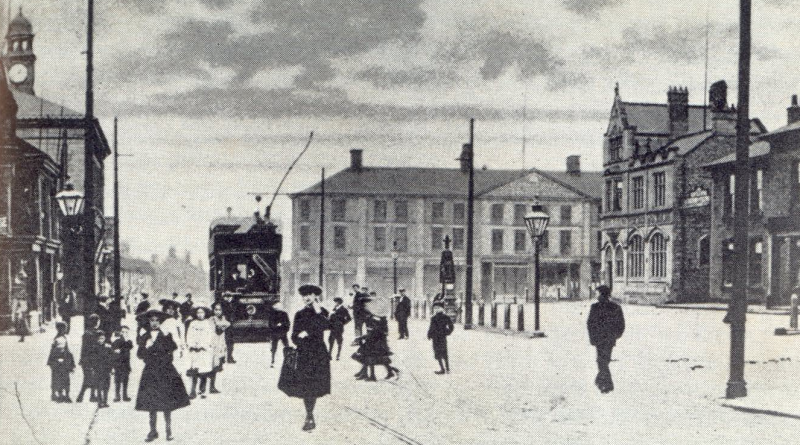 Glossop town centre with electrified trams and decorative street lights. Town Hall is far left. |
| 1911 | Census The Town Hall was recorded as a property with 3 main rooms occupied by Thomas Hall 68, the Town Hall Caretaker, his wife Grace Hall 69, married 44 years with 5 children (3 died). Also at this address was their grandson Leonard Hall Whithead 16, a Bleachworks Calenderer. |
| 1911 |  King George V’s coronation was held on 22 June 1911. Photograph courtesy of Glossop Heritage Trust. |
| 1919 | The last Glossopian to perpetuate his name by donation to the town was Isaac Jackson who started as a saddler in Victoria Street. His later success led in 1919 to him buying the Town Hall and market rights from Lord Howard and presenting them to the people of Glossop in honour of the fallen of the town in the Great War. |
| 1920 | 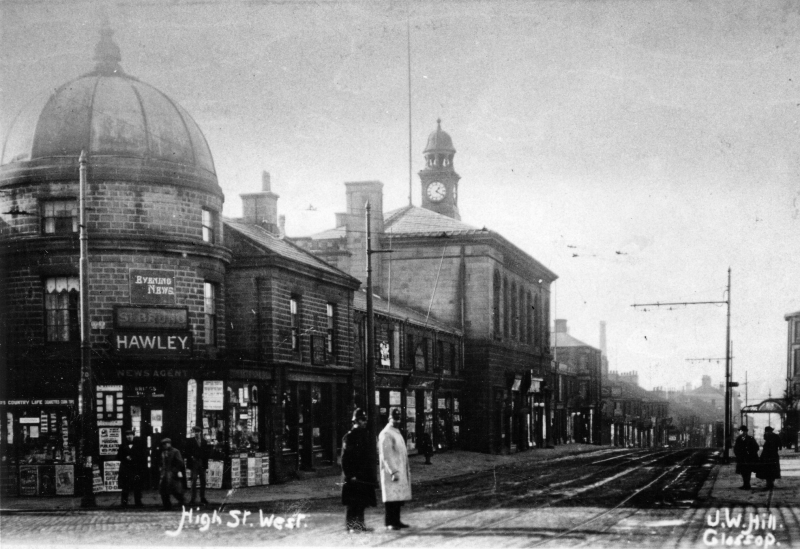 Centre is the Town Hall, the date is somewhere between 1912 and 1927, presuming the trams were still in operation and the glass and cast iron awning on the far right. Photograph courtesy of Glossop Heritage Trust. |
| 1922 | We think the picture above is about 1922, the man on the right is James Whittaker, he and his work colleagues are working on the alterations to the Town Hall / Municipal Building. Photograph courtesy of James’ granddaughter Joan Verner and Ray Verner. |
| 1925 | Kelly’sDirectory Town Hall (Allen Byrom, caretaker), High street west |
| 1925 | Kelly’s Directory Byrom Allen, market inspector, Town hall |
| 1941 | Kelly’s Directory Bowden Ernest, market inspector & caretaker, Town hall Platt T. water inspector, Town hall, High st. west Town Hall (Ernest Bowden, caretaker), High st. west |
| 1941 | Kelly’s Directory Harris Nellie (Miss), fried fish dlr. 131 High st. west |
| 1950 | 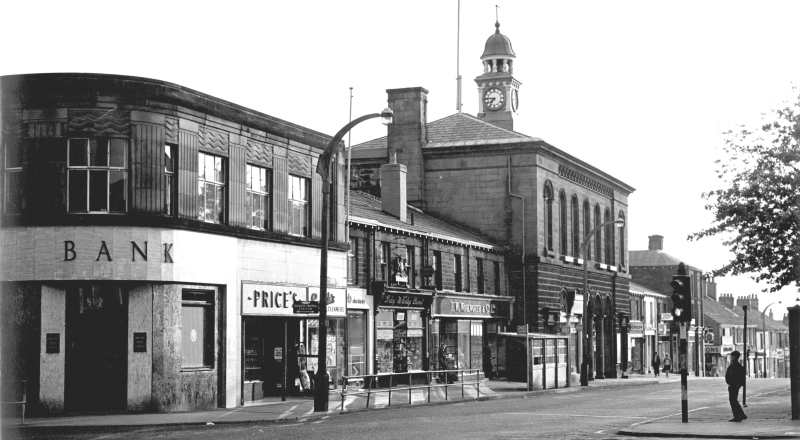 Photograph courtesy of Glossop Heritage Trust. |
| 1950 | 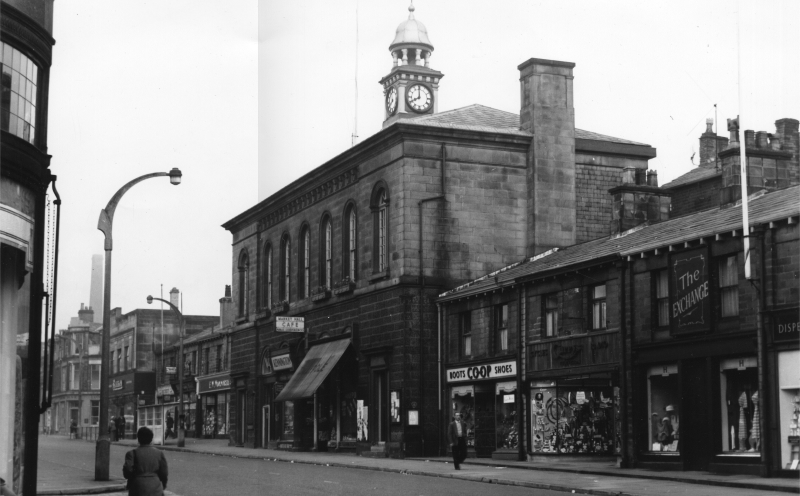 Photograph courtesy of Glossop Heritage Trust. |
| 1958 | English Heritage Grade II Listed Building Town hall, market hall and municipal buildings, 1838, 1845, 1897 and 1923. By Weightman and Hadfield for the 12th Duke of Norfolk. Ashlar millstone grit with ashlar dressings. Panelled stacks and slate roof. STYLE: Classical. PLAN: T-plan. EXTERIOR: 2 storey. North front has 25 windows arranged 3:8:1:5:1:8:2. Central, taller town hall block has 7 windows arranged 1:5:1. Ground floor has vermiculated rustication and central 5 bay open arcade with round arches and Tuscan Doric columns, flanked by single doorways with double doors and moulded ashlar surrounds and bracketed hoods. Above 5 round headed sashes with margin light glazing and bracketed cornice, flanked by single similar windows with glazing bar casements. Above square clock turret, 1897, topped with circular cupola. Side wings, have 4 shops to each side mostly with C20 shop fronts, Nos 7 and 17 retain original shop fronts with console brackets and fascia boards, above 2 windows to each shop divided by plain pilasters. End block to right 2 windows and 3 storeys with curved corner, with 2 shops divided by plain pilasters that continue to upper floors. Municipal offices, south front, has 11 windows arranged 3:5:3. Recessed 5 window centre has central doorway with overlight and single flanking sashes set back behind 2 Tuscan Doric columns in antis with single flanking sashes between similar pilasters. Above 5 sashes topped by parapet with Vitruvian scroll motif stepped to ends. Projecting 3 window gabled wings with overhanging eaves and rusticated vermiculated quoins. Central 2 storey panels with rusticated vermiculated surrounds and paired sashes to each floor, either side single sashes to each floor. All windows have glazing bar sashes. Left and right returns have 2 storey 6 and 4 window facades and beyond 7 tall round headed windows to market hall, central opening to left return has tall rusticated vermiculated door surround. INTERIOR: not inspected. SUBSIDIARY FEATURES: included in this listing are the iron railings and boundary piers to the Market Ground. The original Town Hall design included lock-up prison with 4 cells. (The Buildings of England: Pevsner N: Derbyshire: Harmondsworth: 1953-1986: 219; Hadfield Cawkwell Davidson (Architects): 150 Years of Architects Drawings- Hadfield: Sheffield: 1834-1984). © English Heritage 1958. The National Heritage List Text Entries contained in this material were obtained on 11/6/2013. The most publicly available up to date National Heritage List Text Entries can be obtained from www.english-heritage.org.uk. |
| 2004 | Photograph courtesy of Glossop & District Historical Society. |
| 2007 | Photograph courtesy of Glossop & District Historical Society. |
| 2014 | 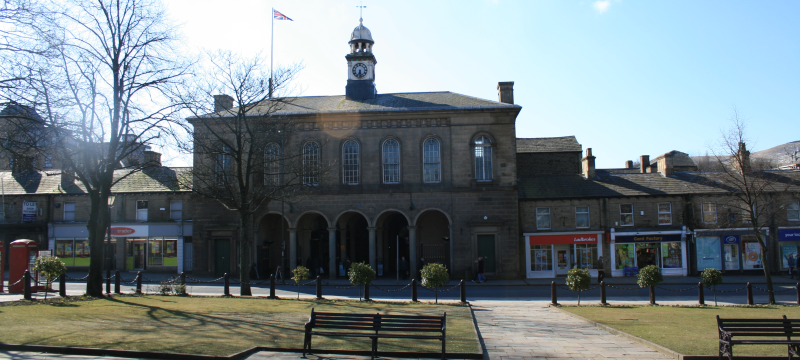 Photo taken in 2014 by Glossop VAH. |
| 2019 | 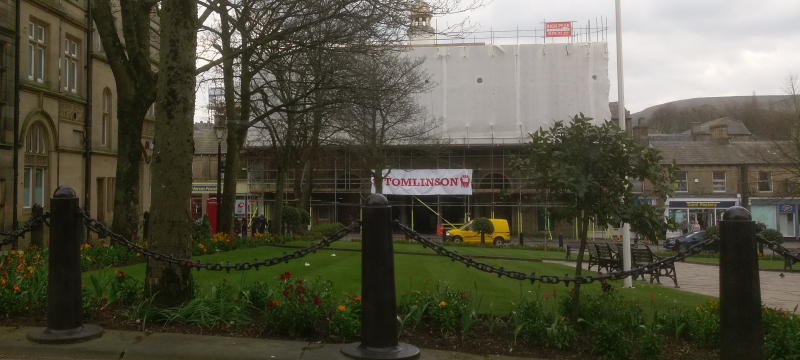 Scaffolding surrounds the town hall and market hall, early 2019, while a muti million pound refurbishment is undertaken by G F Tomlinson Group Limited of Little Eaton, Derby. |